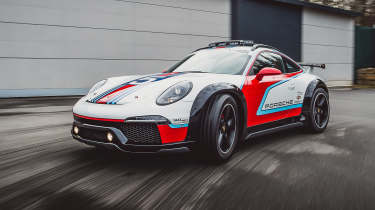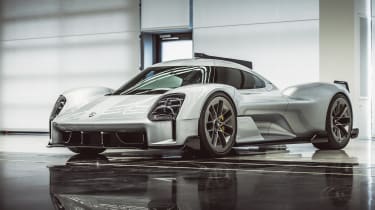Previously unseen Porsche concepts revealed
Design studies give tantalising glimpse of Porsche models that didn’t make production
It’s a quirk of the industry that car design studios work on lots of projects the public will never get to see, developing concepts for models before they’re given the green light for production – or in a majority of cases not. Porsche, however, has opened the back door of its studio to reveal projects created to help shape its future design language, and to show how sometimes that language is tested on some unexpected applications.
Of the designs revealed, two directly reference Porsche motorsport cars. The first is a road-going interpretation of the successful 919 endurance racer and is called the 919 Street. The bespoke bodywork is draped atop the dimensions of a 919 competition chassis, with space for its hybrid powertrain and a two-seater cockpit. While the shape is familiar, the stylised bodywork is a contrast to the highly functional and therefore sometimes odd-looking Le Mans-winning racer.
Porsche pulled out of its successful LMP1 endurance racing campaign in 2017 – the year this 919 Street clay model was created – but had it still been in the game this design study could well have been an early mock-up of a possible Le Mans Hypercar-class contender, for which a road-going equivalent would need to be produced.
The second motorsport-inspired study dates from 2019 and is called the Vision Spyder, and it takes its bearings from a much older, yet no less iconic racer – the 1954 550-1500 RS Spyder. Said 1950s car was a compact open-top competition version of the standard 550 Spyder, built to prove the performance capability of Porsche’s new overhead quad-cam 1500cc four-cylinder engine. And it did so successfully too, competing at the Carrera Panamericana rally in Mexico, where it beat two factory-entered Ferraris despite the engine’s compact 1.5-litre capacity.
The Vision Spyder takes plenty of that racer’s cues, but has transformed them into a contemporary form with new interpretations of iconic elements such as the subtle wing-tips over the rear wheels and a curved frameless screen. The two-seater cabin is also framed with a modern take on the roll-hoop fitted to the racer, here constructed from a web of carbonfibre.
While the overall design is still very much driven by motorsport, unlike the 919 Street the Vision Spyder is a study that will also help define Porsche’s future design language on its production models. So although this is not a direct look at a new-generation Boxster, the rumours of a smaller sub-Boxster model from a few years ago spring to mind as a possible application, and there’s a hint of another compact four-cylinder open-top car from Porsche’s back catalogue in the design too, the 914.
A third design study was an experiment to see how Porsche’s design philosophy would mesh with a genre of car it’s not had experience with in the past. The ‘Renndienst’ from 2018 is a six-seater family van, built with packaging derived from an all-electric chassis like that seen on the Volkswagen ID.3. Porsche also revealed a selection of other derivative, motorsport and pure design exercises, and while none are unlikely to directly preview any of Porsche’s future models, they are examples of how design studios across the industry often go off-piste in the development of a design language, with hundreds of never-to-be-seen designs hidden away from public eyes.










